Stuffed grape leaves are a delicious Mediterranean mezze. In my meatless version of this recipe, I stuff blanched grape leaves with rice, fresh herbs, and pine nuts. Lemon zest adds a lovely essence. They’re especially nice chilled, served alongside other salads and cold mezze for a light summer meal. If you’ve never tried them before, this is a fun vegan cooking project with healthy, delicious results!
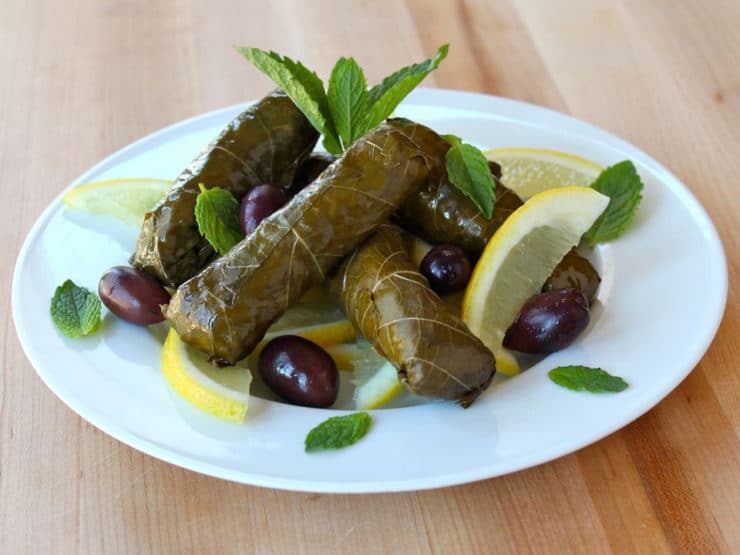
Stuffing grape leaves used to intimidate to me. It seemed like such a complicated, foreign process. I sought advice from a friend of ours named Tony, who owns a Greek restaurant in Malibu. Tony makes the best meat-stuffed grape leaves ever (fingers crossed he’ll share his recipe with me soon!). He told me that stuffing grape leaves is a lot easier than it seems– all you really need is a little time and patience.
I decided to take his advice and try making vegetarian grape leaves first. And you know what? He’s right! There was a learning curve, but once I understood the process, it became second nature. The first time I made them, I used a simple herbed rice as a filling. Over time I tweaked it, adding more herbs, onion, and lemon for flavor and pine nuts for texture/protein.
The result? Delicious! Not to mention vegan, parve, gluten free, healthy– you get the idea.
How to Make Stuffed Grape Leaves
I’ve provided a clearly photographed step-by-step tutorial. Are you lucky enough to have a pesticide-free grape vine in the back yard? Use those leaves! If you don’t (wish I did!), you’ll need to buy 1 or 2 large jars of grape leaves. You can find these at Middle Eastern markets or specialty stores. They can also be found online. I usually end up using a little more than 1 large jar, since many of the leaves end up damaged and unsuited to stuffing. You can use the damaged leaves to line the bottom of the pot, which helps to prevent scorching.
When to Serve Stuffed Grape Leaves
I often make these vegan stuffed grape leaves for the Jewish holiday of Sukkot. On this holiday we are encouraged to create dishes from fresh seasonal ingredients. Sukkot ushers in the autumn season, and menus are inspired by the bounty of the harvest. That means lots of apples, squash, eggplants, figs, grapes, and– you guessed it– grape leaves!
While these are very appropriate for Sukkot, you can obviously serve these stuffed grape leaves year-round. They’re especially nice served chilled during the hot summer months. Garnish them with fresh mint leaves, lemon slices and olives for a lovely presentation.
Other Mezze Recipes:
Recommended Products:
We are a participant in the Amazon Services LLC Associates Program, an affiliate advertising program designed to provide a means for us to earn fees by linking to Amazon.com and affiliated sites. As an Amazon Associate I earn from qualifying purchases.
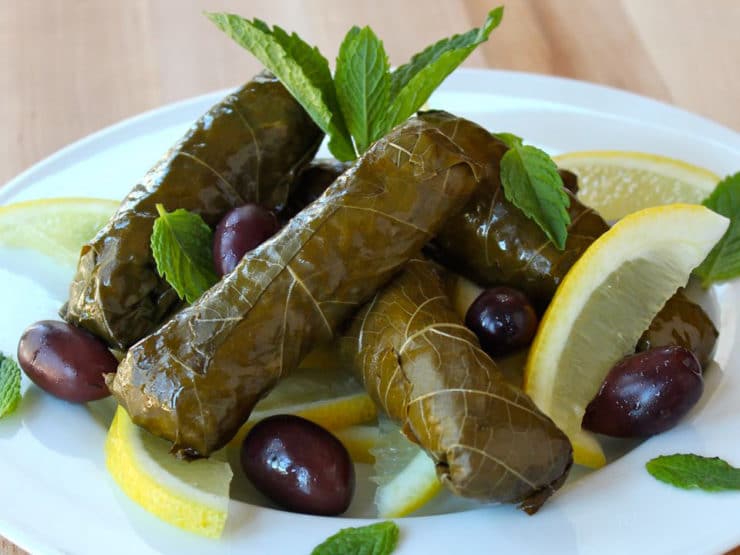
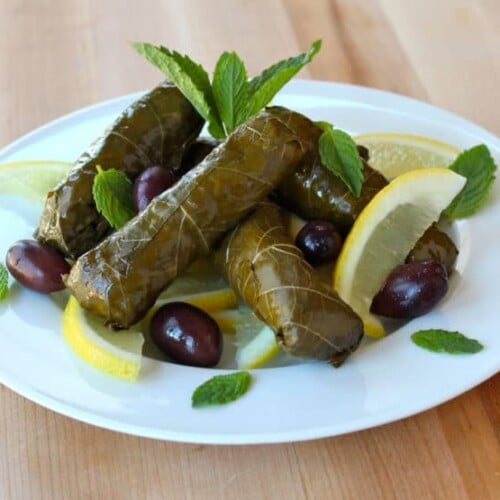
Vegetarian Grape Leaves (Dolmades)
Ingredients
- 1/2 cup pine nuts
- 1 1/2 cups long grain white rice
- 1 medium onion, minced
- 1/2 cup fresh minced dill
- 1/4 cup fresh minced mint
- 6 tablespoons freshly squeezed lemon juice, divided
- 1 tablespoon lemon zest
- 1 3/4 cups vegetable broth (a yellow broth is best), divided
- 50 large grape leaves (fresh or jarred)
- Salt and pepper
- 1/2 cup extra virgin olive oil
- Fresh mint leaves, lemon slices, and olives (for garnish - optional)
NOTES
Instructions
- Pour the pine nuts into a skillet and lightly toast them over medium heat till golden brown. Reserve.Pour ¼ cup of olive oil into a medium pot and heat it over medium. Add minced onion to the pot and sauté until soft. Add the rice to the pot and stir to combine. Sauté for another minute. Pour in ¾ cup vegetable broth and lower the heat; simmer the rice uncovered for about 10 minutes till the liquid is absorbed and the rice is half cooked. Do not cook the rice fully, or you’ll end up with mushy grape leaves! Just cook it to an al dente texture. Remove pot from heat.

- Add the minced dill, mint, toasted pine nuts, 2 tbsp fresh lemon juice and lemon zest to the pot of rice. Stir till all ingredients are well combined. Season with salt and pepper to taste. Let the mixture cool to room temperature.

- Fill a large pot with salted water and bring to a boil. As the water is heating, trim the leaves by cutting the stems off, flush with the leaves. Trim any large, hard veins from the leaves. Place the leaves in the boiling water and let them soften for 3-5 minutes till they become pliable (fresh leaves may take a bit longer to soften than jarred).

- Drain, then cover the leaves with cold water. Drain the leaves again and pat them dry.Note: If using fresh leaves, try to use younger leaves (medium size)—they’ll be more tender than the very large leaves.

- Place a grape leaf shiny (smooth) side down, vein (bumpy) side up, on a flat surface like a cutting board.

- Place 2 tbsp of rice filling at the base end of the leaf, near where the stem was.

- Fold the stem end up over the filling.

- Fold the edges of the leaf inward.

- Continue rolling the leaf till it forms a neat rolled package. Do not roll too tightly; the rice will expand a little during cooking, and if you roll it too tight the leaf will unravel as it cooks.

- Squeeze the roll gently to seal.Repeat the process with the remaining leaves till all of the filling is gone.

- As you roll the leaves, you may find some leaves that are damaged or have large holes. Place those damaged leaves into the bottom of your saute pan to line it and create a bed for the stuffed leaves.

- Place the stuffed leaves in the bottom of the saute pan. Don’t be afraid to pack the leaves snugly; this will help keep the leaves intact as they cook. Make a single layer on the bottom of the pan. When you run out of room, make a second layer on top.

- Pour 1 cup of broth, ¼ cup of extra virgin olive oil, and ¼ cup of fresh lemon juice over the stuffed grape leaves. Heat the pan over medium until it begins to simmer (don’t boil, or the leaves will start to fall apart).Cover the pot. Let the grape leaves cook for 30-40 minutes. The leaves are finished cooking when they are fork-tender.

- Stuffed grape leaves can be served warm or cold, as-is or topped with a variety of sauces. I like serving them with fresh tzatziki or tahini sauce—recipes for both can be found on my blog. Store them in the refrigerator; they will keep for about 1 week.

Nutrition

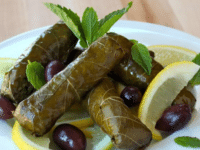
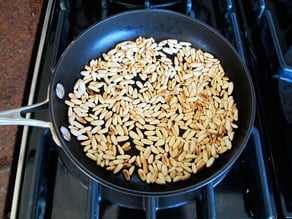
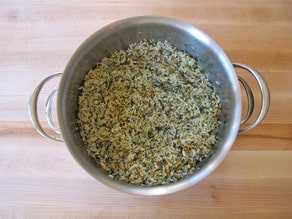
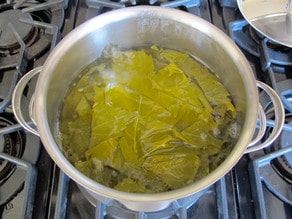
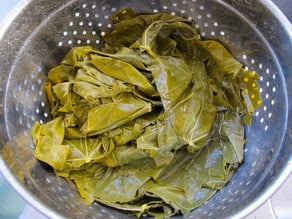
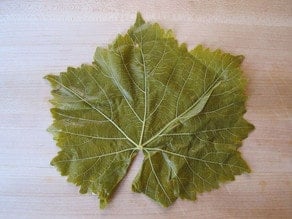
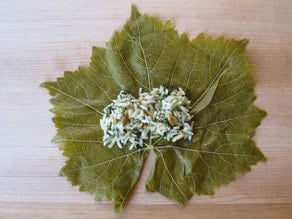
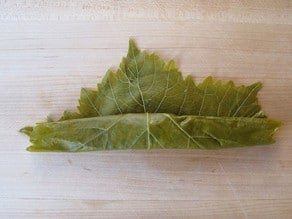
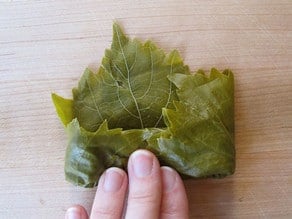
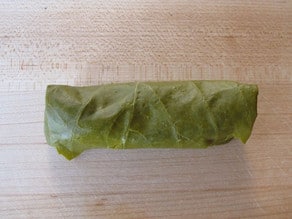
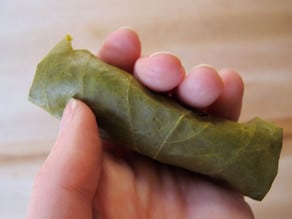
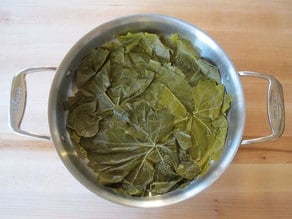
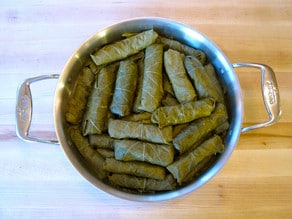
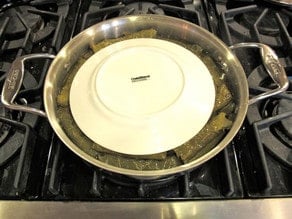
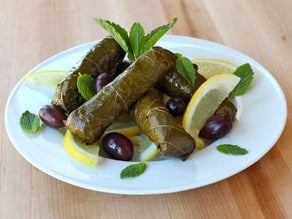


These were fantastic – made them for a greek themed dinner party and they were enjoyed by all. Dealing with the grape leaves was time-consuming but everything else was very easy. My grape leaves came in a jar with brine so I rinsed but did not cook or blanch before stuffing and cooking. They came out perfectly.
In the picture above you show a plate over the dolmades but don’t explain what that is about in the written instructions (unless I missed it) I saw that technique on another recipe so knew what to do.
I can not wait to make these again!
Super disappointed in this. While the taste was there, boiling the grape leaves made them tear just by looking at them. I tried another recipe that was similar in flavor profile, and all you did was rinse the leaves, and ended up with a much better result. Even with so many leaves tearing and being unusable, there still wasn’t nearly enough filling for the rest of my grape leaves, so the scale isoff on this, also.
Sorry to hear that Kerri! This recipe has been made and enjoyed many times by readers, I’ve never heard those complaints before. I never like to hear that someone didn’t have a great result. Perhaps it’s the brand of grape leaves you used that caused them to tear? Maybe they’re more delicate than the brands I’ve tried. I don’t feel the scale is off here, as I’ve made this many times – but I will revisit it soon just to double check.
These were great! I squeezed lemon juice over them and put them in the fridge. Even better the next day! Thank you!
Hi Tori,
My sweet deceased Jordanian Auntie Anna taught me her Veggie grape leaves:
Rice, garbanzo beans, parsley, mint, onions,garlic, red chili flakes, salt & pepper & lots & lots of lemon juice during the cooking process.
Enjoy !
Shalom, Lydia Carlson
Shalom Lydia! They are the best on a warm summer day.
This brings me back to my childhood and teens, though my family made them with minced beef mixed with the rice, cooked pieces of dried apricots, but will most definitely have a go at this way, the ones you get here (UK) in the shops ready made are deep in oil, looking forward to make them your way, thanks!!!
Followed recipe, turned out great. I used frozen grape leaves left over from summer. Recipe was easy to follow and it smelled delicious. Have not tried them yet, but am sure I will not be disappointed. Reliable recipe!! Thank you.
Enjoy Anthoula! I really strive to make all my recipes reliable and delicious, I test them rigorously before posting.
i froze my grape leaves this year in zip lock bags and laid them flat with warnings “do not put anything on top of these” they are so much easier to roll after they freeze..i layered paper towels in between layers and works wonderful also the recipe is very good first time i have made them but have tasted them before! we live near Edmonton where our weather gets to near 40 below and have been growing grapes for 30 some years and mostly only made jelly with the grapes until someone made and gave us a some to try ……and we loved them! They called them Dolmades!
Lynda ~ curious ~ did you parboil the leaves before freezing, or were they frozen fresh from the vine?
Wow! This recipe rocks, Thanks Tori <3
I was able to use fresh leaves from my abundant grape vine in the back yard ~ what a treat! I boiled and salted water, then added the leaves and turned off the heat. They sat in the water for 15 minutes and this was perfect.
I used basmati rice. It worked well.
Only one fell apart ~ ta da!
I made some of these from another similar recipe. Unfortunately I managed to rescue only about a dozen as the rest fell apart! Reading this one, I see where I probably went wrong. Will have another go and this time won’t roll them so tightly, and not let the water boil but just simmer. I wondered whether they should have an egg to keep it all together? Anyway the rest wasn’t wasted. My daughter said it was so tasty she ate it all!
I love this recipe and made it a second time yesterday. My challenge is with the odd shapes of the grape leaves, which I get from jars, as I don’t have a way to get fresh ones here in Boston. I feel like half of the leaves either come in shapes that are completely not able to accommodate a spoon of filling or tear so easily when separated, that I just end up throwing them.
Any suggestions for the best variety of canned leaves?
Usually my local markets don’t have too many options on brands for the leaves. I often run into the problem you are having. I just use the misshapen ones to line the bottom of the pan.
That’s a great suggestion to use the damaged leaves for lining the pot! We made these all the time growing up, but was never a fan of the scorched ones at the bottom of the pot. Your idea addresses both issues! Thank you Tori Xx
You’re welcome! It saved me a lot of grief when I learned it 🙂
I just made these with my own grape leaves, I have three varieties and the leaves differ quite a bit from each vine. My leaves were smaller than those pictured here, so it was hard to roll them up. I sliced a raw potato and put on the bottom of the pan to protect them while cooking and they were easily removed from the pan. Delicious!
Well done Tori, nice and accurate recipe, wonderful. .keep it coming..
I haven’t had a chance to make this exact recipes yet, however I am a big fan of stuffed grape leaves. I eat them often for lunch with soup or as a quick snack. I am curious to know if you have the nutritional breakdown for this particular recipe. I would appreciate it very much if you are able to provide it! Thank you for your wonderful recipe and photos!
Hi Sharon, Tori’s assistant Ashley here. We do not currently have the nutritional breakdown for this recipe.
Can you substitute another leaf for the grape leaf? It is not easy to come by where I am
Wayne-You might try using rainbow chard..I’ve seen recipes for films using chard leaves.
They can be done with nasturtium leaves. They have a different flavor so may taste better with a somewhat different filling.
Try collard greens. Makes a bigger bundle but very flavorful. You can add smashed up kidney beans or chick peas to it too, and a smudge of tomato paste.
Yes you can I am Greek my mum used white cabbage leaves after removing hard stalks from separated leaves stuck them in a saucepan boil in salted water till pliable but not too soft and stuff enjoy
Hi Wayne (better late than never replying!)
Another alternative is sorrel, which has a lovely lemony taste naturally.
When we lived in San Diego, I used fresh nasturtium leaves from our yard with good results!
Made these and they were awesome
Amazing work! But why do you need to roast the nuts? Why?
Hi Farah, Tori’s assitant Ashley here. Roasting nuts brings out more of their natural flavor and helps them to stay crisp when mixed into filling.